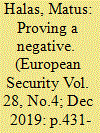| Srl | Item |
| 1 |
ID:
168964


|
|
|
|
|
| Summary/Abstract |
The increased Russian foreign policy assertiveness and the related security concerns associated with the Eastern Flank of NATO caused a revival of interest in European deterrence after more than two decades of neglect. Yet the absence of a military invasion into the Baltics does not necessarily imply a successful deterrent threat. Quite the contrary: a detailed analysis using Boolean logic suggests that deterrence does not really work in the Baltics, neither at the conventional, nor at the sub-conventional level. A lack of capabilities undermines the credibility of NATO’s conventional deterrence posture despite its clear effort to communicate the threat to the other side. The only reason why the lack of capabilities on the Eastern Flank has no negative consequences for the Alliance is because Russia has (currently) no need to advance its state interests by resorting to military force. At the same time, deterrence fails repeatedly at the sub-conventional level and it will probably continue to fail in the future. Incidents like the relocation of the Bronze Soldier Memorial in 2007, the kidnapping of a security officer in 2014 or the violations of airspace in 2018 can escalate to a full-blown crisis. Limiting the number of such incidents should be the main goal of the cumulative deterrence of hybrid threats.
|
|
|
|
|
|
|
|
|
|
|
|
|
|
|
|
| 2 |
ID:
190099


|
|
|
|
|
| Summary/Abstract |
To what ends do allies employ military exercises? In order to further our understanding regarding the logic and utility of military drills, this paper focuses on NATO’s eastern flank. Specifically, with the help of newly compiled data, we tracked two decades of exercises in the Baltic states. Our analysis speaks to the fact that the size, tempo, and character of military training events in this region have manifestly changed. In the early 2000s, military drills were primarily conceived as a mechanism to modernize Baltic armed forces and ensure their adequacy to NATO membership standards. The 2014 Crimea crises, however, dealt a serious blow to the regional order. This event was the primary driver behind a considerable spike in the overall exercise numbers. At the same time, we observe that it was not only a mere quantitative shift that transpired. From parachute drops into remote areas, rehearsals of river crossings to moving of combat power via narrow land corridors, the staging of military exercises after 2014 were overhauled into events that accentuated NATO’s reinforcement capabilities. In this context, military exercises can be seen as a crucial element to credibly signal capacity and resolve within the concept of deterrence by reinforcement.
|
|
|
|
|
|
|
|
|
|
|
|
|
|
|
|